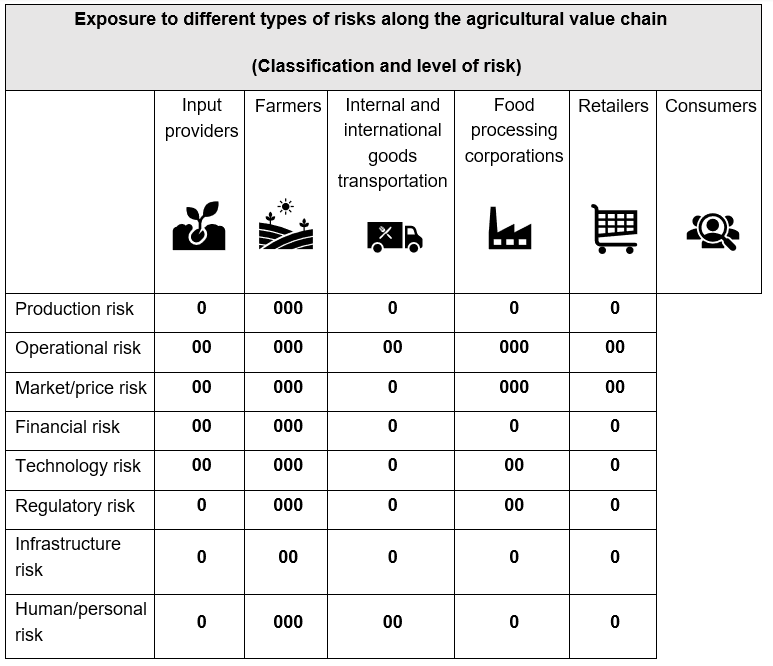Agriculture and Risk

This post is also available in:
This post is also available in:
![]() Español (Spanish)
Español (Spanish) ![]() Français (French)
Français (French) ![]() Deutsch (German)
Deutsch (German) ![]() Nederlands (Dutch)
Nederlands (Dutch) ![]() हिन्दी (Hindi)
हिन्दी (Hindi) ![]() العربية (Arabic)
العربية (Arabic) ![]() Türkçe (Turkish)
Türkçe (Turkish) ![]() 简体中文 (Chinese (Simplified))
简体中文 (Chinese (Simplified)) ![]() Ελληνικά (Greek)
Ελληνικά (Greek) ![]() Português (Portuguese (Brazil))
Português (Portuguese (Brazil)) ![]() polski (Polish)
polski (Polish)
Introduction
Around 10.000 years ago man started progressively transitioning from widespread hunter-gathering nomadism to fixed settlements in many regions of the world1. Controlling where, how, and when to secure regular food through animal and plant domestication, without the need to regularly move to better hunting grounds over long, perilous distances, created the first farms and fortified human settlements.
The enhanced ability to satisfy basic needs such as shelter and food security, reduced men’s exposure to a variety of destructive or potentially destructive situations, greatly increasing human populations’ odds to survive and adapt to different, sometimes difficult, environments. Food grown at our own door can be easily collected, and given the right circumstances, be stored for consumption the whole year-round. The lingering threat of death due to inanition, falling prey to dangerous animals over death-defying terrain or exposure to unsafe climatological elements was greatly reduced.

The birth of agriculture is probably one of man’s most compelling, and enduring risk management approaches2. It had and continues to have a profound, pervasive, transversal effect in human life across multiple contexts: cultural, sociological, financial, economic, demographic, political, biological, environmental, climatological, geographical, and the list goes on. However, with the change of context and circumstances, new threats confronted this new way of human life and the people practicing it, the farmers.
Even if mankind’s ability to survive was greatly increased due to more predictable ways to assure food security, agriculture is not a zero-risk activity. Agriculture is an occupation fundamentally prone to ambiguous outcomes due to its contact with several situations over which the farmer doesn’t have control over. Even nowadays, it is considered a risky business2.
Agriculture is “the science, art, or practice of cultivating the soil, producing crops, and raising livestock and in varying degrees the preparation and marketing of the resulting products”3. At their most fundamental, agricultural activities comprise the production of crops, forest products, livestock, and/or fish (we can consider it a form of livestock though with its obvious particularities) products. All these are interdependent biological systems (i.e., plants, animals, fungi, bacteria, etc.) immersed in specific geographical, environmental, climatological, air, light, humidity, water, soil interfaces and contexts.
Ultimately, a farmer wishes that his/her efforts lead to a viable generous harvest/yield at the end of a production cycle; that his/her trees survive long enough so that their trunks and branches can be used for fruits production, wood, fire, fiber, or bark; that his/her cow gives birth to a new calf, continuing the cycle of the dairy or meat herd; that there are sufficient grazing areas for extensive/semi-extensive livestock feeding or for the production of animal silage to support the animals on winter days; they expect that the water course thriving with fish they produce for consumption or to be sold on the market and that consistently runs within its boundaries, does not overflow or dry out, leading to a loss of such protein and income source.
Risk definition and implications in agriculture
Risk is ever present in our lives. Agriculture is no exception. Behind this word another one shadows it: uncertainty.
On a more apprehensive note, risk may mean the doubt over the future and the incomplete knowledge of what is to come, the higher or lesser probability of an unfortunate occurrence or event happening, the ambiguity regarding the outcome of a situation, the possibility of loss or injury.
On a more encouraging note, risk can also mean the anticipatory chance to earn a benefit or a reward by staking a bet or venturing in an investment.
Within the agricultural value chain, farmers are exposed, henceforth to several risks4:

Exposure to risk: High 000 Medium 00 Low 0
From all the intervening participants within this value chain, farmers assume the highest level of exposure to different risks. Production risk is highly dependent on weather phenomena affecting farmers individually, and catastrophe risk systemically affecting whole regions or countries.
Risk and its components: risk matrix (Intensity vs Frequency)
Risk can express itself at different levels. The higher probability that certain outcomes will be produced when compared to others will depend on their Frequency (how many times an event or series of events occur over a period) and Intensity (how serious that event or series of events will be over same period). To this we call the “risk matrix”.
Events that occur less Frequently and with less Intensity will naturally imply a lower risk (i.e., probability) of , say, loss of yields or income for the farmer.
High Frequency and/or High Intensity risks are the source of enhanced anxiety. They may affect not only one farmer but a series of farmers within one same region/country compromising entire farming value chains across a wide area.
Recurring, extreme storms with the potential to destroy a year’s crop yield every year, sometimes more than once per year, may have a bigger or lesser impact on farmers within a certain region, area or even a country within a specific timeframe.
Climate change, unfortunately, is making this type of severe occurrences more prevalent as weather patterns change to the extreme, and without warning. Farmers’ historical experiences cultivating a crop in a certain region may now be completely outmoded as they navigate the enhanced uncertainty of climate change-induced new climatological/weather patterns.
Choosing the right farming production strategies (e.g., the most adapted seeds, fertilizers, cultural practices, etc.) becomes less straightforward if the circumstances of production diverge wildly and incongruently from historical patterns. The risk of being a farmer is now clearly heightened due to heightened uncertainty.
Perils, hazards, exposure
Perils are the situations that may lead to a loss. A hazard is something that influences the expression of a peril. Exposure is a quantified and qualified measure of the potential risk of events emanating from perils farmers face from their normal activities.
Examples of common perils related to agricultural production risk: fire, flood, drought, strong winds, storm, lightning, landslide, pests, and diseases. These may change according to the geographical context of the farm or plot (e.g., “loss of branches due to heavy snow fall” is a peril that may affect forests located in mountainous or colder regions but not of such a high probability of occurrence in tropical rain forests, hence of a lesser risk on that situation; less hazardous).
A forest comprised solely of Eucalyptus trees (an Oceania species), extremely combustible due to their high content in volatile/flammable oils, is more probable to combust quickly, burn totally, and difficult to put out a summer fire in a Mediterranean climatological setting (i.e., dry, hot summers) if a lightning strikes than a forest populated by Mediterranean trees species. For example, trees of the gender “Quercus sp.” (e.g., oaks, cork trees), besides having specific biological adaptations to the Mediterranean climate which enhance their survivability chances to events like fire and drought, don’t have such content of highly flammable, volatile oils, which fuel the intensity of such event. A tropical rain forest with historically on-average all-year round high-humidity levels, is also less probable to be subjected to natural fires or to be totally consumed by them when compared to the illustrated Eucalyptus Forest plantation in a Mediterranean setting.

This is a physical hazard. In this case, the physical attributes of forest plantations, i.e., their location, regional prevailing climatological/weather patterns, and the tree species’ populating them matter, making them more or, less hazardous to the peril fire. The historical record of such events’ occurrence should be the tangible proof of such considerations.
Fires, however, can also be ignited, unfortunately, by the willful human hand, not only by randomized, accidental and unforeseen events as a lightning strike. In the case where the human hand purposefully ignites a fire, we call this the expression of a moral hazard.
Moral hazard is a concept that is prevalent in agricultural insurance. Situations where both physical and moral hazards concur, can happen. They elevate risk exposure to a higher level.
References:
1 Brown, T. (2022) The development of Agriculture, National Geographic Society. National Geographic Society. Available at: https://education.nationalgeographic.org/resource/development-agriculture (Accessed: November 10, 2022).
2 Choudary, V., Baedeker, T. and Johnson, T. (2015) Making the Risky Business of Agriculture ‘climate-smart’, World Bank Blogs. World Bank Group. Available at: https://blogs.worldbank.org/voices/making-risky-business-agriculture-climate-smart (Accessed: November 10, 2022).
3Agriculture definition & meaning (no date) Merriam-Webster. Merriam-Webster. Available at: https://www.merriam-webster.com/dictionary/agriculture (Accessed: November 4, 2022).
4Tsiboe, F. and Turner, D. (2022) Risk in agriculture, USDA ERS – Risk in Agriculture. USDA ERS. Available at: https://www.ers.usda.gov/topics/farm-practices-management/risk-management (Accessed: November 12, 2022).
Read more in the articles below:
Agriculture and Risk
Risk Management Approaches in Agriculture
Insurance – A Financial Tool to Offset and Manage Risk
Agricultural Insurance – A Financial Tool for Farmers to Offset and Manage Risk








































































